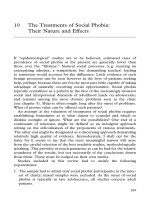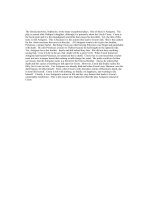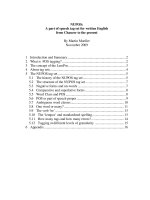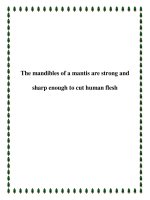6480The thackery t lambshead cabinet of curiosities exhibits, oddities, images, and stories from top authors and artists
Bạn đang xem bản rút gọn của tài liệu. Xem và tải ngay bản đầy đủ của tài liệu tại đây (8.56 MB, 1,221 trang )
The
Thackery T. Lambshead
Cabinet of Curiosities
Exhibits, Oddities, Images,
and Stories from Top Authors
and Artists
Edited by
Ann & Jeff VanderMeer
Dedication
Dedicated to the memory of Kage
Baker,
a wonderful writer and a good
friend of Dr. Lambshead.
You are not forgotten.
Contents
Cover
Title Page
Dedication
Introduction: The
Contradictions of a Collection:
Dr. Lambshead’s Cabinet
Holy Devices and Infernal
Duds: The Broadmore
Exhibits
The Electrical
Neurheographiton
—Minister Faust
St. Brendan’s Shank
—Kelly Barnhill
The Auble Gun—Will
Hindmarch
Dacey’s Patent
Automatic Nanny—Ted
Chiang
Honoring Lambshead:
Stories Inspired by the Cabinet
Threads—Carrie
Vaughn
Ambrose and the
Ancient Spirits of East and
West—Garth Nix
Relic—Jeffrey Ford
Lord Dunsany’s
Teapot—Naomi Novik
Lot 558: Shadow of
My Nephew by Wells,
Charlotte—Holly Black
A Short History of
Dunkelblau’s
Meistergarten—Tad
Williams
Microbial Alchemy and
Demented Machinery: The
Mignola Exhibits
Addison Howell and
the Clockroach—Cherie
Priest
Sir Ranulph
Wykeham-Rackham,
GBE, a.k.a. Roboticus the
All-Knowing—Lev
Grossman
Shamalung (The
Diminutions)—Michael
Moorcock
Pulvadmonitor: The
Dust’s Warning—China
Miéville
The Miéville Anomalies
The Very Shoe
—Helen Oyeyemi
The Gallows-horse
—Reza Negarestani
Further Oddities
The Thing in the Jar
—Michael Cisco
The Singing Fish
—Amal El-Mohtar
The Armor of Sir
Locust—Stepan Chapman
A Key to the
Castleblakeney Key
—Caitlín R. Kiernan
Taking the Rats to Riga
—Jay Lake
The Book of
Categories—Charles Yu
Objects Discovered in
a Novel Under
Construction—Alan
Moore
Visits and Departures
1929: The Singular
Taffy Puller—N. K.
Jemisin
1943: A Brief Note
Pertaining to the Absence
of One Olivaceous
Cormorant, Stuffed
—Rachel Swirsky
1963: The Argument
Against Louis Pasteur
—Mur Lafferty
1972: The
Lichenologist’s Visit
—Ekaterina Sedia
1995: Kneel—Brian
Evenson
2000: Dr.
Lambshead’s Dark Room
—S. J. Chambers
2003: The Pea—Gio
Clairval
A Brief Catalog of Other
Items
Artist and Author Notes
Story Contributors
Artists
Catalog Contributors
About the Editors
Acknowledgments
Credits
Other Books by Ann & Jeff
VanderMeer
Copyright
About the Publisher
Introduction:
The Contradictions of a
Collection: Dr. Lambshead’s
Cabinet
By the Editors
A photograph of just one shelf in
Lambshead’s study displaying the
“overflow” from his underground
collection (1992). Some items were
marked “return to sender” on the
doctor’s master list.
To
his dying day, Dr. Thackery T.
Lambshead (1900–2003) insisted to
friends that he “wasn’t much of a
collector.” “Things tend to manifest
around me,” he told BBC Radio once,
“but it’s not by choice. I spend a large
part of my life getting rid of things.”
Indeed, one of Lambshead’s biggest
tasks after the holiday season each year
was, as he put it, “repatriating well-
intentioned gifts” with those “who might
more appropriately deserve them.”
Often, this meant reuniting “exotic”
items with their countrymen and women, using his wide network of
colleagues, friends, and acquaintances
hailing from around the world. A
controversial reliquary box from a
grateful survivor of ballistic organ
syndrome? Off to a “friend in the Slovak
Republic who knows a Russian who
knows a nun.” A centuries-old
“assassin’s twist” kris (see the Catalog
entries) absentmindedly sent by a lord in
Parliament? Off to Dr. Mawar Haqq at
the National Museum in Kuala Lumpur,
Malaysia. And so on and so forth.
He kept very little of this kind of
material, not out of some loyalty to the
Things of Britain, but more out of a
sense that “the West still has a lot to
answer for,” as he wrote in his journals.
Perhaps this is why Lambshead spent so
much time in the East. Indeed, the east
wing of his ever-more-extensive home in
Whimpering-on-the-Brink
was
his
favorite place to escape the press during
the more public moments of his long
career.
Regardless, over time, his cabinet
of curiosities grew to the point that his
semipermanent loans to various
universities and museums became not so
much philanthropic in nature as “acts of
self-defense”
(LIFE
Magazine,
“Hoarders: Curiosity or a New
Disease?,” May 19, 1975). One of the
most frenzied of these “acts” occurred in
“divesting myself of the most asinine
acquisition I ever made, the so-called
Clockroach”—documented in this very
volume—“which had this ridiculous
habit of starting all on its own and
making a massacre of my garden and
sometimes a stone fence or two. Drove
my housekeeper and the groundskeeper
mad.”
Breaking Ground
This question of the cabinet’s growth
coincides with questions about its
location. As early as the 1950s, there are
rather unsubtle hints in Dr. Lambshead’s
journal of “creating hidden reservoirs
for this river of junk” and “darkness and
subterranean calm may be best for the
bulk of it,” especially since the
collection “threatens to outgrow the
house.”
In the spring of 1962, as is welldocumented, builders converged on
Lambshead’s abode and for several
months were observed to leave through
the back entrance carrying all manner of
supplies while removing a large quantity
of earth, wood, and roots.
Speculation began to develop as to
Lambshead’s intentions. “If even Dr.
Lambshead despairs of compromise,
what should the rest of us, who do not
have the same privilege, do?” asked the
editor of the Socialist Union Guild
Newsletter that year, assuming that
Lambshead, at the time a member, was
building a “personalized bomb shelter
with access to amenities many of us
could not dream to afford in our
everyday lives, nor wish to own for fear
of capitalist corruption.” In the absence
of a statement from Lambshead, the Fleet
Street press even started rumors that he
had discovered gold beneath his
property, or ancient Celtic artifacts of
incredible
value.
Whatever
Lambshead’s motivations, he must have
paid the builders handsomely, since the
only recorded comment from the
foreman is: “Something’s wrong with the
pipes. Full stop.” (Guardian, “Avowed
Socialist Builds ‘Anti-Democracy’
Bunker Basement,” April 28, 1962)









